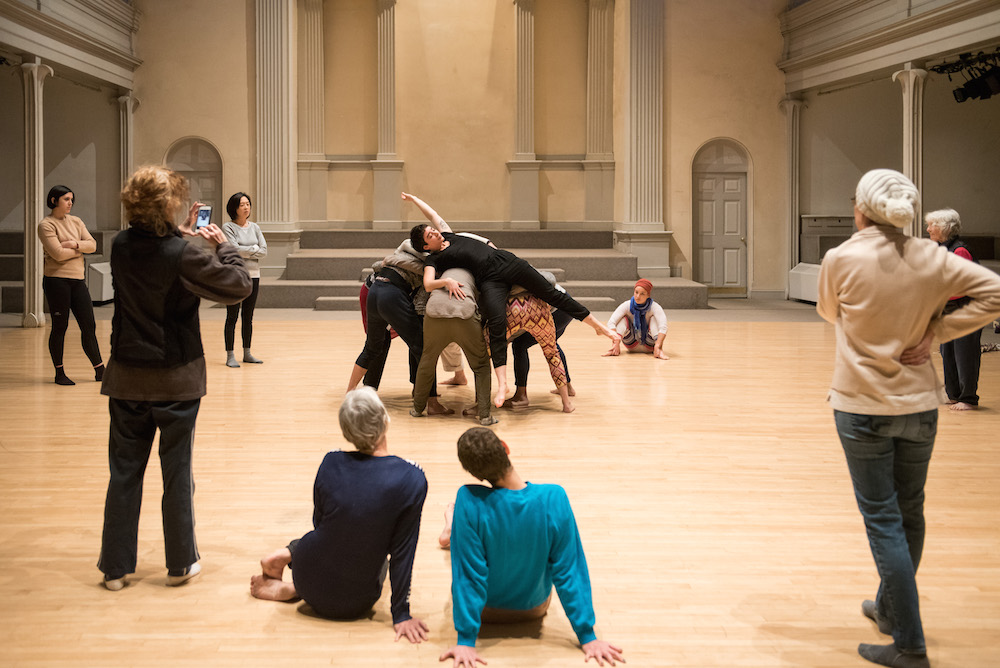Justin Cabrillos: Flock/Huddle/Describe/Seesaw
February 6, 2017
In December 2016, Danspace Project and the Museum of Modern Art (MoMA)’s Department of Media and Performance Art collaborated on an unprecedented Research Residency with artist Simone Forti, on the occasion of MoMA’s acquisition of Forti’s Dance Constructions (1961). During the weeklong residency, Forti, invited guests, and the public engaged in discussions and workshops to ensure that this work is brought to the dance community and the new generations who will carry it forward. Below, artist and performer Justin Cabrillos responds to her experience working with Forti:
Flock:
I’m approaching a crowd of bodies reminding myself, Step into the space between people. A number of birds of one kind feeding, resting, or travelling together. A number of domestic animals, especially dancers, that are kept together. Pass through that space between people. A large number of people, a crowd, gathers to go in a flock: a band or company of persons. We found space as a way of being together.
Huddle:
A brief gathering of bodies to receive instructions, especially in American Football. One action: to crowd together, nestle closely, to huddle.
Go slowly so that the audience can witness the game. The construction itself can create movement or situation, shifts the relation between body movement and sculpture: crowd together and nestle closely.
The distinction between life and art is less pronounced on the West Coast, but what is essential: to see the form in space so that it’s seen as a form and has beauty, formally human.
To huddle and give mass. Also necessary: how pressure moves through the group, how to see the intuitive shifting around, using the whole mass of the body. Have a private discussion; Curl one’s body into a small space. Heap together in a disorderly manner. Confer, meet obstacles and negotiate being part of the mass.
It was easier to climb onto the top of the huddle when the shin was on the lower back of the person supporting you. Dancers experience the huddle by heaping together. Artists look at it conceptually.
She slowed it down to see the decisions. Simone decided to move to New York and decided to make Huddle after seeing so much urban space and approached the body as part of nature as something that has mass and solidity.
A close grouping of people or things. Step closer to the crease of the hip to keep the knee–of the person supporting you–safe. I just needed something solid, so that a mountain made of organic material has consciousness.
After a warm up involving arm swings and Tai Chi, huddling earth. The climber is the earth that becomes conscious, then becomes obstacle, becomes part of the earth. After an event a huddle may take place to congratulate one another for the team’s success, or to commiserate a defeat.
She wanted Huddle to be pedestrian and not stylized. It’s an action of a team gathering together, usually in a tight circle, to strategize, motivate or celebrate. It is a popular strategy for keeping opponents insulated from sensitive information, and acts as a form of insulation when the level of noise in the venue is such that normal on-field communication is difficult. Simone said when she made Huddle (to huddle and give mass) that she was going through a break up.
Describe:
Black
Curtain
Black
Bag
Seesaw:
A situation characterized by rapid, repeated changes from one state or condition to another. As one end goes up the other goes down. Example: Simone and her dancers tried everything they could think of on the seesaw, also known as a teeter-totter, a long narrow board supported by a single pivot point, most commonly located at the midpoint between both ends.
Robert Dunn’s assignment:
Jump and land with a different number of body parts.
A long plank balanced in the middle on a fixed support, on each end of which children sit and swing up and down by pushing the ground alternately with their feet.
Midpoints:
John Cage
Anna Halprin
Action Painting
Bob Morris
Each work creates its own situation. Literally, this-that, seemingly attributable to the back-and-forth motion for which a dance is known. We can be completely still and affect the balance. As in, the transmission of that dance to this body.
–Justin Cabrillos
